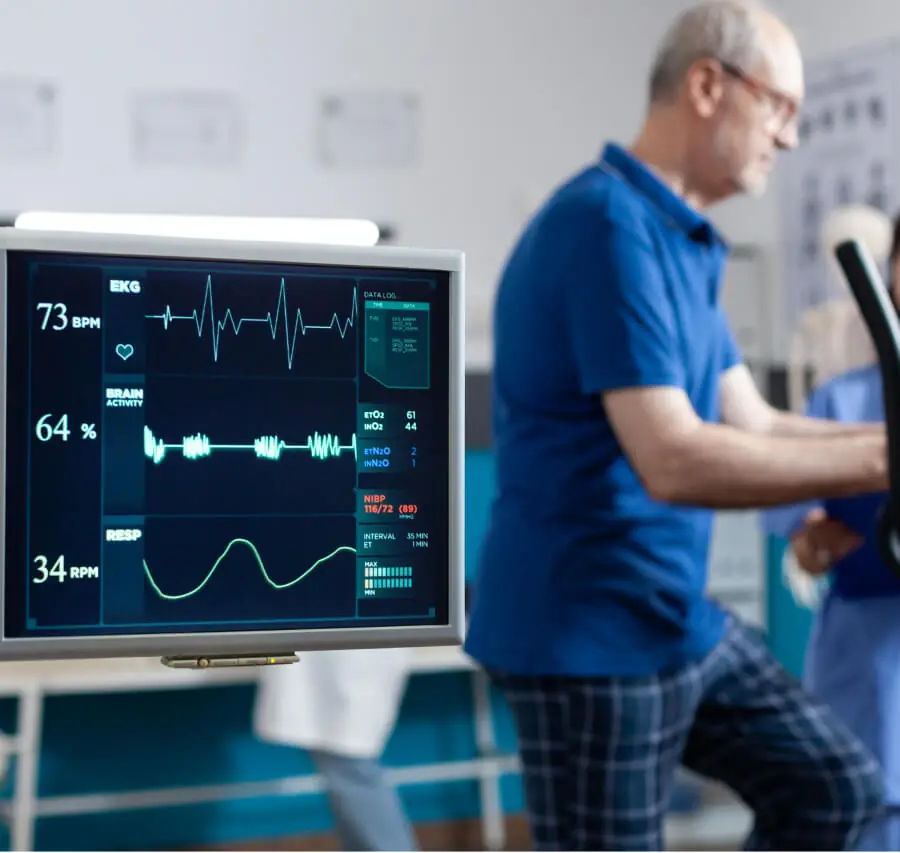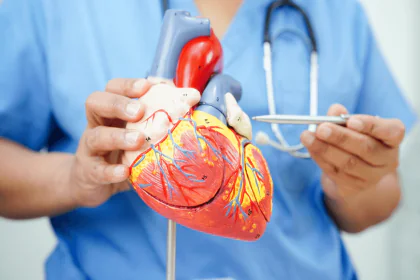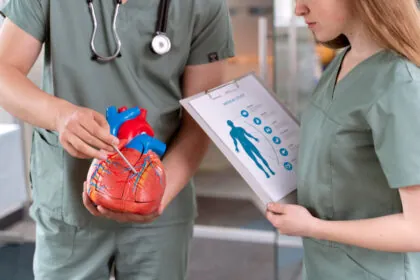Have you ever wondered what your heart is doing when you feel it beating in your chest?
How does it keep up with your changing needs and emotions?
How does it cope with stress, exercise, or illness?
And most importantly, how can you tell if your heart is healthy or not?
Your heart is a complex and fascinating organ that works tirelessly to keep you alive and well.
It has its own electrical system that regulates the rate and rhythm of your heartbeat, and ensures that blood flows smoothly throughout your body.
But sometimes, this electrical system can malfunction, causing problems such as irregular heartbeats, chest pain, shortness of breath, or palpitations.
These problems can indicate a serious condition such as a heart attack, arrhythmia, or heart failure, which can have life-threatening consequences.
Fortunately, there is a simple and painless test that can reveal a lot about your heart’s health and function.
It is called an electrocardiogram, or ECG for short.
An ECG can record the electrical activity of your heart, and show how fast, regular, and strong your heartbeat is.
It can also detect any damage or abnormalities in your heart muscle, valves, or arteries, and help diagnose and monitor various heart conditions.
In this article, we will explain everything you need to know about ECG, including what it is, why it matters, how it works, what it can tell you, and how to prepare for it.
We will also provide some tips and resources to help you take care of your heart and prevent any problems in the future.
By the end of this article, you will have a complete understanding of how an ECG reveals your heart’s secrets, and how you can use this information to improve your health and well-being.
What is an ECG?
An ECG (Electrocardiogram) is a simple, painless, and non-invasive test that records the electrical activity of the heart.
An ECG can show how fast the heart is beating, whether the heartbeat is regular or irregular, and how strong and steady the electrical signals are.
An Electrocardiogram can also detect any damage or abnormalities in the heart muscle, valves, or arteries.
An ECG is performed by attaching electrodes (small, sticky patches) to the chest, arms, and legs of the patient.
The electrodes are connected to a machine that displays the electrical signals as waves on a screen or paper.
The ECG machine can also measure the time intervals between the waves, which indicate how long the electrical impulses take to travel through the heart.
What types of ECG are there?
There are different types of Electrocardiogram that can be used for different purposes.
Some of the common types are:
Resting ECG
This is the most basic type of Electrocardiogram that is done when the patient is lying down and relaxed.
It can show the normal functioning of the heart or detect any problems that occur at rest, such as:
- Ischemia (lack of blood flow to the heart)
- Heart block (a delay or interruption in the electrical signals).
Stress ECG
This is a type of ECG that is done when the patient is exercising or under physical stress.
It can show how the heart responds to increased demand for oxygen and blood, or detect any problems that occur only during exertion, such as:
- Angina (pain in the chest brought on by a decrease in cardiac blood flow)
- Coronary artery disease (narrowing or blockage of the arteries that supply blood to the heart).
Holter monitor
This is a type of ECG that is done over a longer period of time, usually 24 to 48 hours.
It involves wearing a small, portable device that records the heart’s electrical activity continuously.
It can show how the heart behaves during normal daily activities, or detect any problems that occur intermittently, such as:
- Abnormal cardiac beats, or arrhythmias
- Silent ischemia (lack of blood flow to the heart without symptoms).
Event monitor
This is a type of Electrocardiogram that is done over a longer period of time, usually a few weeks or months.
It involves wearing a small, portable device that records the heart’s electrical activity only when the patient presses a button or experiences symptoms.
It can show how the heart behaves during specific events, or detect any problems that occur rarely, such as:
- paroxysmal atrial fibrillation (a type of arrhythmia that comes and goes).
What are the benefits and risks of an ECG?
An ECG is a safe and useful test that can provide valuable information about the heart’s health and function.
An Electrocardiogram can help diagnose and monitor various heart conditions, such as:
Heart attack
An ECG can show if the heart muscle has been damaged or deprived of oxygen due to a blocked artery.
An ECG can also show the location and extent of the damage, and help guide the treatment and recovery.
Arrhythmia
An ECG can show if the heart is beating too fast, too slow, or irregularly due to a problem in the electrical system.
An ECG can also identify the type and cause of the arrhythmia, and help determine the best treatment and prevention.
Heart failure
An ECG can show if the heart is enlarged, weakened, or stiffened due to a chronic condition that affects the heart’s ability to pump blood.
An Electrocardiogram can also show the severity and progression of heart failure, and help optimize the management and prognosis.
Heart valve disease
An ECG can show if the heart valves are leaking, narrowed, or infected due to a congenital defect, aging, or infection.
An ECG can also show the impact of the valve disease on the heart’s function and structure, and help decide the need and timing of surgery or other interventions.
An Electrocardiogram has no significant risks or side effects.
The electrodes may cause some minor discomfort or skin irritation, but they are easily removed after the test.
The ECG does not emit any radiation or electricity, and does not interfere with other devices such as pacemakers or implantable cardioverter-defibrillators (ICDs).
How to prepare for an ECG?
An Electrocardiogram is a simple and quick test that does not require much preparation.
However, there are some general tips that can help ensure a smooth and accurate ECG:
Wear comfortable and loose-fitting clothing that can be easily removed or lifted to expose the chest, arms, and legs.
Avoid wearing any jewelry, metal objects, or electronic devices that may interfere with the electrodes or the Electrocardiogram machine.
Avoid applying any lotions, creams, or oils to the skin that may affect the adhesion or conductivity of the electrodes.
Avoid smoking, drinking caffeine, or taking any stimulants that may alter the heart rate or rhythm before the test.
Inform the doctor or technician of any medications, supplements, or medical conditions that may affect the heart or the ECG results.
Follow the instructions of the doctor or technician during the test, such as lying still, breathing normally, or exercising as directed.
What to expect after an ECG?
An electrocardiogram usually takes only a few minutes to complete, depending on the type and purpose of the test.
After the test, the electrodes are removed and the patient can resume their normal activities.
The electrocardiogram results are then analyzed and interpreted by a doctor, who will explain the findings and implications to the patient.
The Electrocardiogram results may also be compared with previous or subsequent ECGs to monitor any changes or trends in the heart’s condition.
The ECG results may also be used to guide further tests or treatments, such as blood tests, echocardiogram, angiogram, or medications.
Conclusion
An Electrocardiogram is a valuable test that can reveal a lot about the heart’s health and function.
By recording the electrical activity of the heart, an Electrocardiogram can show how fast, regular, and strong the heartbeat is, and detect any damage or abnormalities in the heart muscle, valves, or arteries.
An Electrocardiogram can help diagnose and monitor various heart conditions, such as heart attack, arrhythmia, heart failure, or heart valve disease.
An Electrocardiogram is a safe, painless, and non-invasive test that does not require much preparation or recovery.
An Electrocardiogram can provide important information that can help improve the quality and longevity of life for people with heart problems.
FAQs
What is an ECG and how does it work?
An ECG, or electrocardiogram, is a medical test that records the electrical activity of the heart over a period of time.
It works by attaching electrodes to the skin, which detect and measure the electrical impulses generated by the heart’s muscle cells.
Why is an ECG important for heart health?
An ECG is crucial for assessing the heart’s rhythm and detecting any abnormalities or irregularities.
It helps diagnose various heart conditions, such as arrhythmias, heart attacks, and other cardiac issues, providing valuable insights for effective medical intervention and treatment.
How is an ECG performed, and is it a painful procedure?
The Electrocardiograms procedure is painless and non-invasive.
Small electrodes are attached to the skin on the chest, arms, and legs to capture the heart’s electrical signals.
The patient simply lies still while the machine records the data, which is then interpreted by a healthcare professional.
What conditions can an ECG help diagnose?
Electrocardiograms are used to diagnose a range of heart conditions, including atrial fibrillation, ventricular tachycardia, coronary artery disease, and heart attacks.
The test is an essential tool for cardiologists to evaluate the heart’s electrical activity and identify potential issues.
Are there any risks or limitations associated with ECGs?
Electrocardiograms are generally safe and have minimal risks.
However, they may not detect all heart conditions, and false positives or negatives can occur.
Additionally, ECGs are just one part of a comprehensive cardiac evaluation, and other tests may be necessary for a complete assessment.
Can an ECG be done at home, and are there portable devices available?
While traditional Electrocardiogram are performed in a medical setting, advancements in technology have led to the development of portable ECG devices that can be used at home.
These devices are user-friendly and can provide valuable information for monitoring heart health, especially for individuals with certain cardiac conditions or risk factors.
However, it’s important to consult with a healthcare professional for proper guidance.





